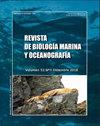Dieta del pato quetru no volador Tachyeres pteneres en un humedal marino de Chiloé, sur de Chile
IF 0.5
4区 生物学
Q4 MARINE & FRESHWATER BIOLOGY
引用次数: 2
Abstract
The Magellanic Flightless Steamer Duck (Tachyeres pteneres) is the only marine anatid founded along the coastline of Chile and Argentina, from Valdivia to Tierra del Fuego. There is little published information about the quantitative diet of this species. Previously, a single study of its breeding diet was reported for Guapiquilan Island, Chiloe, southern Chile. We studied T. pteneres' winter diet during 2011 and 2012 in Bahia Caulin, Chiloe, southern Chile. We found that statistically Cancridae crabs (100 and 100%, respectively) and Majidae (96.0-71.4%, respectively) were the most common items in the diet of this species.智利南部奇洛埃海洋湿地中不会飞的奎特鲁鸭的饮食
麦哲伦无飞蒸鸭(Tachyeres pteneres)是唯一一种在智利和阿根廷海岸线上发现的海生鸭,从瓦尔迪维亚到火地岛。关于该物种的定量饮食,目前几乎没有公开的信息。此前,智利南部奇洛的瓜皮基兰岛曾报道过对其繁殖饮食的单一研究。我们研究了2011年和2012年在智利南部奇洛的巴伊亚考林的T.pteneres冬季饮食。我们发现,从统计数据来看,Cancridae螃蟹(分别为100%和100%)和Majidae(分别为96.0-71.4%)是该物种饮食中最常见的食物。
本文章由计算机程序翻译,如有差异,请以英文原文为准。
求助全文
约1分钟内获得全文
求助全文
来源期刊
CiteScore
0.70
自引率
0.00%
发文量
41
审稿时长
12 months
期刊介绍:
Publicar desde una perspectiva científica, artículos originales, decididos por un proceso de revisión por pares, invitando a expertos de reconocido prestigio en el área. Los trabajos publicados se caracterizarán por su solidez teórica-metodológica, actualidad y relevancia para las ciencias marinas.
Se reciben trabajos inéditos derivados de la investigación científica realizada en ambientes marinos y estuarios, en formato de Revisión, Artículos, Notas Científicas, y Obituarios en las siguientes disciplinas::
Biología-Ecología marina
Oceanografía física, química y biológica
Contaminación marina
Geología marina
Sistemática, Faunística y Biogeografía Marina
Manejo Costero
Acuicultura marina
Pesquería marina.

 求助内容:
求助内容: 应助结果提醒方式:
应助结果提醒方式:


